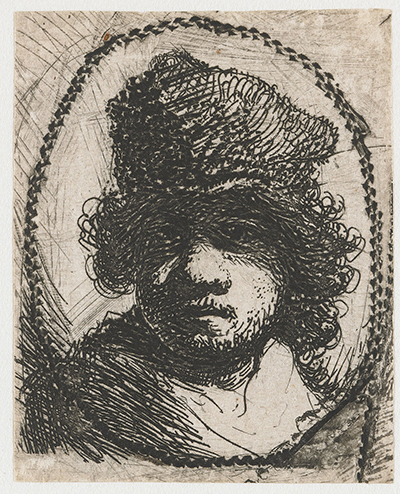This etching print has a starker contrast in its use of light and dark than many of Rembrandt's other self portraits, though this may as much be down to the printing technique used rather than the design of the original etching.
This piece is dated at 1629, and Rembrandt focused on this genre a great deal from around 1628-1631. Much of the output from that period are still around today, partly due to the fact that each etching would have several series of prints distributed which greatily increased their chances of surviving to the present day. They would initially enter private collections for nominal fees, though in recent centuries there has been an attempt by major art galleries and institutions to acquire some of them for their own collections. The print found in front of us here comes from the etching titled Self Portrait in a Fur Cap, in an Oval Border, and is now owned by the British Museum in London, having changed hands several times between British collectors. That institution employs some of the finest art historians in the world, but we were still unable to find much content on this particular piece, such is the extraordinary size of their collection.
It was at this point in his career, when he was in his mid-twenties, that Rembrandt had started to see the medium of etching as equivalent to painting, which was highly unusual for that period. He did not see it as an opportunity of making more money from existing paintings, by reproducing copies of them, but rather desired to explore the possibilities of etching, dry point and related techniques in order to produce work within them to the same level as those who specialised in it. He actually went beyond them, in the end, but at this stage of his career he was still honest enough to say that he had much to learn and would consult other engravers for assistance and advice from time to time. He would also study the work of engravers from years past, and acquired some of their work for his own private collection.
The oval border found within this version of his self portrait etchings is perhaps the most obvious element to stand out as unique. It is not particularly precise and looks more like a stamp than anything hard carved by the artist. Specialists in this field would likely be able to better explain how it came to being, but the shape almost gives the impression of a coin, in which Rembrandt's face has been added. A larger version of this image is available at the British Museum and it shows how this pattern continues vertically down much further, and then around a larger frame. Further research is needed in order to understand this better as he does not use this technique much elsewhere.




